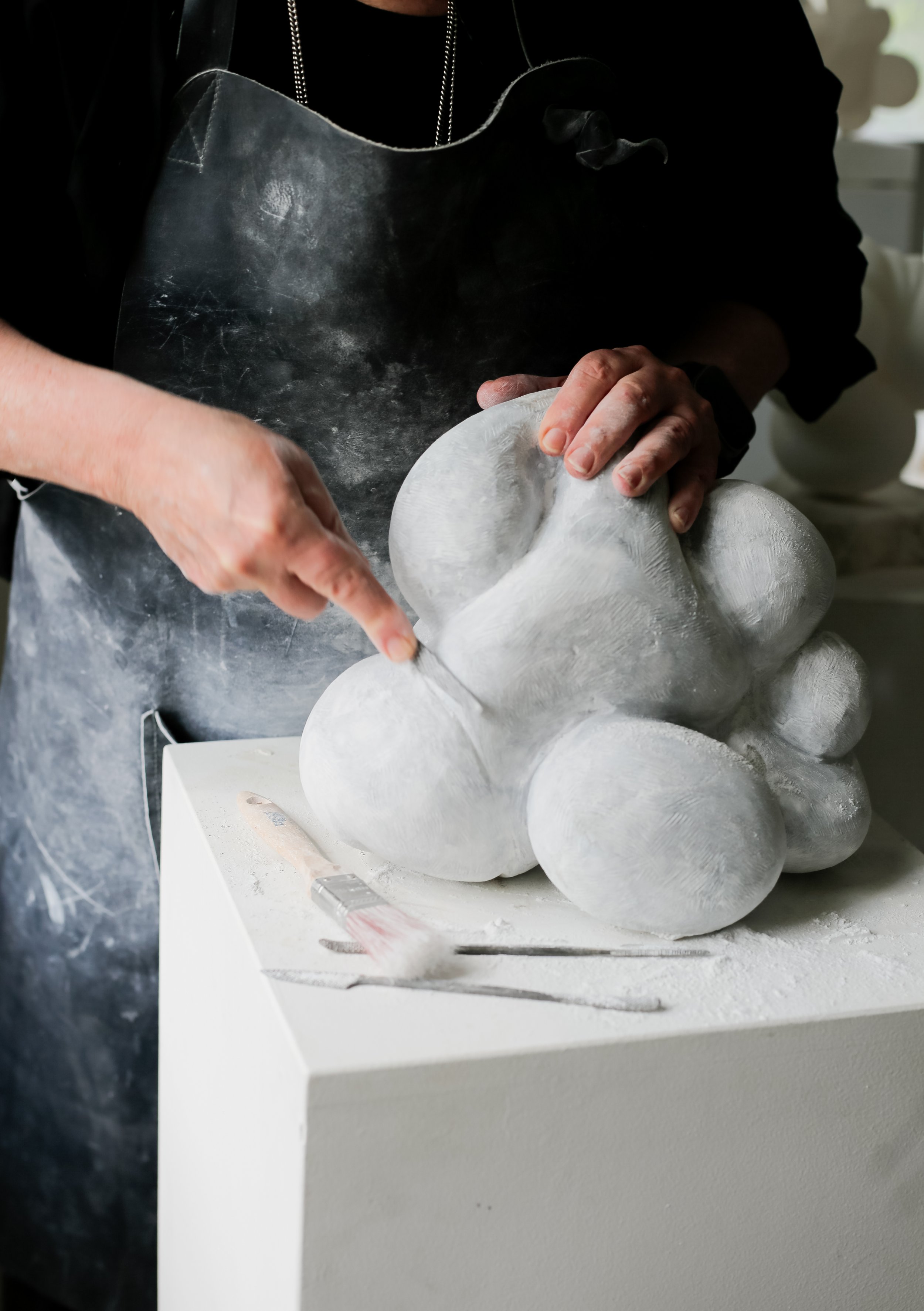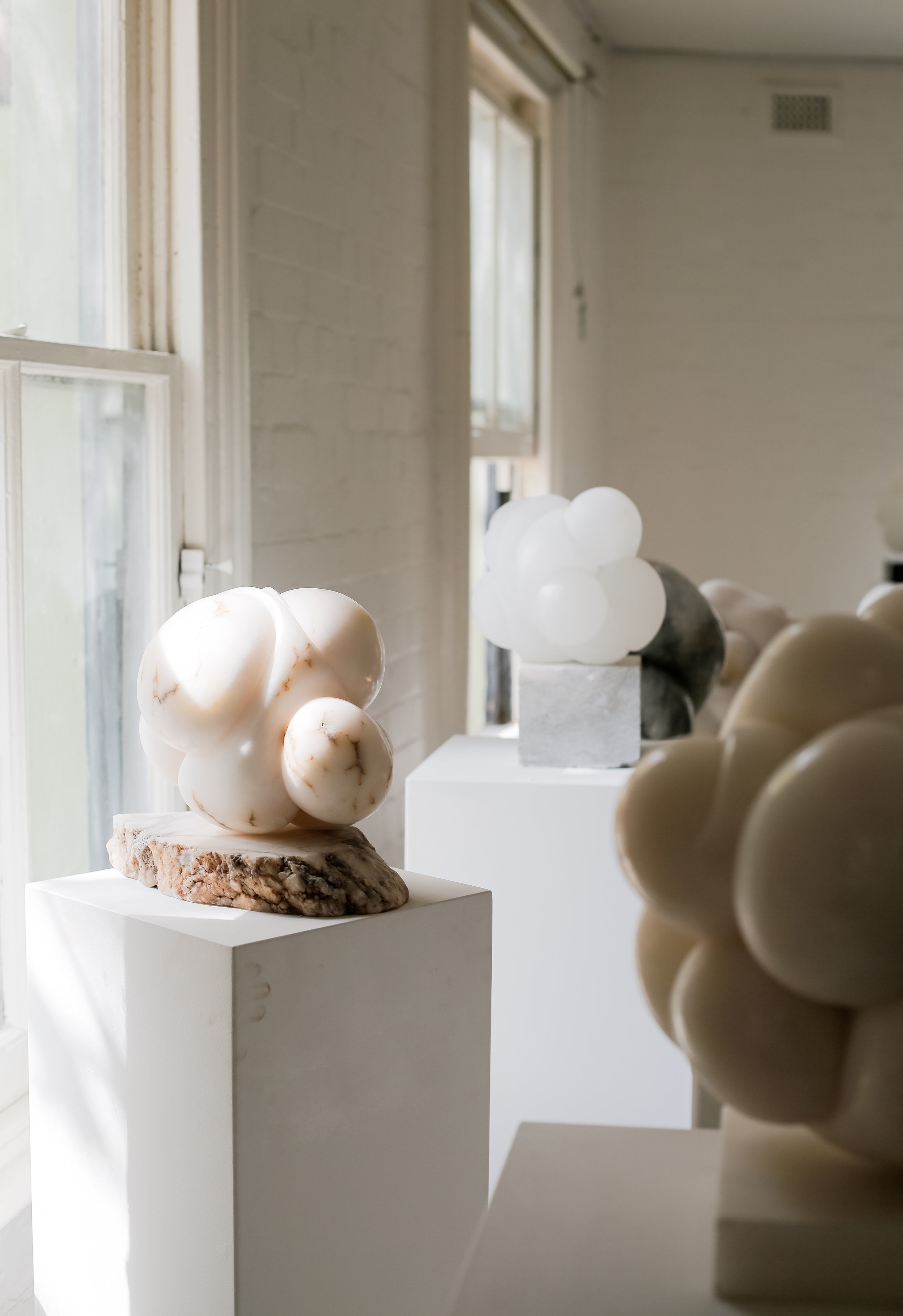Carol Crawford—A Labour Of Love
With a deep understanding and love of her craft, Carol Crawford creates sculptures that carry with them a sense of knowing and connection to something deeper.
Words: Cardia Speziale I Photography: Hande Renshaw
Sculptor Carol Crawford in her Surry Hills studio in Sydney.
‘I have a fascination with three-dimensional form, I also love the way sculpting involves all your senses. Working on one side of a sculpture can affect the other sides. There are problems to be solved and resolving these in a way that aesthetically pleases me is why I am attracted to sculpture,’ says Carol Crawford.
Carol Crawford creates her sculptures with natural materials including alabaster, marble, and soapstone.
‘Light is so important when working with sculpture, and in particular alabaster,’ says Carol Crawford.
‘I sometimes call myself the stone psychologist… I listen to what it is telling me, I am not forcing my opinion on the stone.’
Armed with a variety of natural materials including alabaster, marble, and soapstone, and working from her Surry Hills studio in Sydney, artist and sculptor Carol Crawford takes a slow and steady approach to her work, finding inspiration in her natural surrounds, and the generations that lived before her.
Carol’s interest in art began from a young age where she discovered a fascination in the patterns and structures of nature. After studying Art History at Sydney University, where she garnered insights into the history of the world through the lens of an artist, Carol began attending classes at a sculpture school run by Tom Bass AM—a still thriving educational institution which she now sits on the board of.
‘Creativity has always been a part of my life; however, it wasn’t until my youngest child turned 5 years old that I started studying with Tom Bass AM at his atelier studio in Erskineville,’ says Carol. ‘Tom was one of Australia’s greatest modernist public sculptors and someone who devoted his life to teaching sculpture — I was extremely fortunate to be able to study with him until his passing in 2010 at the age of 93,’ she adds.
The soft, seemingly malleable nature of her three-dimensional forms invite the viewers sensors to get as involved as possible; the historic nature of the marble, the translucency of the alabaster—each unique element daring its audience to come closer and feel something deeper.
‘I love the ability to be able to create physical incarnations of my inner “feelings”, it’s incredibly rewarding and brings me a lot of joy to just walk into my studio each day,’ muses Carol. ‘The soft organic forms represent the feminine aspect of my work, not only in their obvious curvaceousness, but also in the sense that nothing is measured or exacting with my work, the forms are organic and free flowing.’
‘Alabaster is the main material I work with, and I love everything about it—I love the dust it makes, the sound of the file as I carve into the stone, the translucency of it, the malleability of the stone and its ability to form beautiful full forms in a natural way.’
‘For inspiration I go into nature, whether that be a beautiful urban bush park or flowers or seeds or even wandering past neighbourhood gardens.’
“I find I have a visceral turn of my stomach when I am completely happy with a sculpture— if my heart skips a beat when I set eyes on the sculpture, I know it is close to being complete.”
Carol Crawford creates her sculptures with natural materials including alabaster, marble, and soapstone.
‘I almost feel I don’t do anything to the raw stone—I’m just listening to it talking to me and bringing out its true nature.’
As important as the method through which she carves stone into sculpture, is the weekly ritual that Carol takes to look after her mental and physical health, through a regular practice of Iyengar yoga. She also talks of deadlines as the ultimate creativity buzzkill, which is the reason commissions are a rarity in her world, ‘unless the client is very patient,’ she smiles.
‘Larger sculptures can take me months to complete; I initially remove any stone I do not want, so that I can simplify the form [...] then I work around the form on all sides, not deciding which way is up or down, nor which side is front or back. Like fine wine,
I have to work slowly and sometimes let the sculpture sit for a few weeks on sandbags, in this way I can decide where I should go with it, or what the sculpture is telling me.’
Reflecting on her time spent learning from Tom Bass AM, Carol muses on the many lessons he taught her that she still uses to this day, including the importance of process and making a sculpture to the best of your ability.
Looking ahead, ‘I would be excited to continue to have the ability and health to continue to create stone and other sculptural forms and to do what I love. One can never take anything for granted,’ she says.












